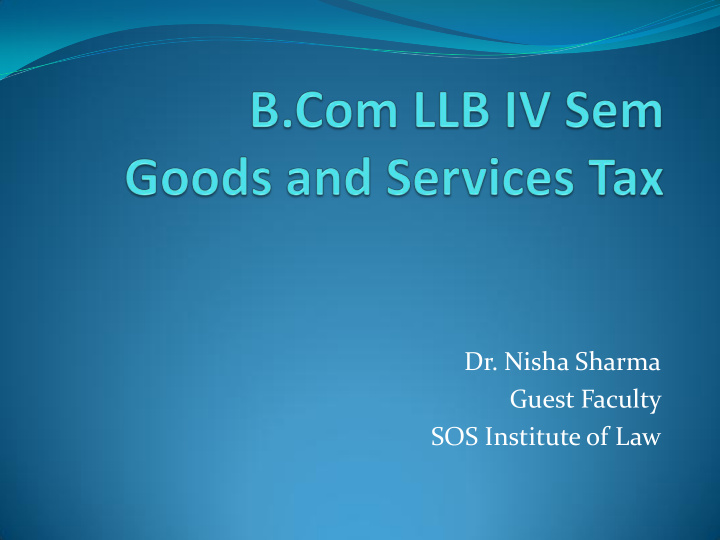



Dr. Nisha Sharma Guest Faculty SOS Institute of Law
Introduction of GST Goods & Service tax(GST) is an indirect tax applicable throughout India which replaced multiple cascading taxes levied by the Central and State government. The tax came into effect from 1 July 2017 through the implementation of the One Hundred and First Amendment of the Constitution of India by the Indian government.GST is a single tax on the supply of goods and services. Meaning of GST- Goods and services tax (GST) is a tax on goods and services with value addition at each stage having comprehensive and continuous chain of set of benefits from the producer’s/service provider’s point up to the retailers level where only the final consumer should bear the tax.
Objectives of GST • One country - one tax • Consumption based tax in stead of manufacturing • Uniform GST registration and payment • To eliminate cascading effect of doubling tax • Reduce corruption and tax evasion • Increase productivity • Increase Tax to GDP and revenue surplus Advantages of GST 1 Unified nation market- GST aims to make India a common market with common tax rates and procedures and remove the economic barriers, thus paving the way for an integrated economy at the national level. 2 Boost to ‘Make in India’ Initiative- GST will a major boost to the ‘Make in India ‘ initiative of the Government of India by making goods and services produced in India competitive in the national as well as international as well as international market .
Advantages of GST Cont…… 3 Neutrality- As it is neutral to business processes, business models, organisational structure, geographical locations and product substitutes, it promotes economic efficiencies and sustainable long term economic growth. 4 Export from India are zero rated- More efficient neutralisation of under GST especially for export ,there by making products more competitive in global market and thus boosting exports from India. 5 Eradicate corruption-Under GST all interaction to be through common GSTN portal. It will ensure least manual interface between the taxpayer and the tax administration. It will definitely effect the corruption. 6 No manual interface- GST is based on IT, which will improve the compliances as all returns to be filled online,
Advantages of GST Cont…… inputs credit to be verified online encouraging more paper trial of transactions. 7 Tax payer’s friendly - GST is an attempt in this regards, as simplified and automated procedure for various processes to remove complexities. Such as registration, returns, refunds, tax payment etc. 8 Reduced evasion- Uniform SGST and IGST rates will reduce the incentive for evasion by eliminating rate arbitrage between neighbouring State and that between intra and inter-State supplies. 9 No GST on essential and daily used goods- Essential and daily used goods (specially agriculture based) have been kept exempt category. Small supplier upto rupees 40 lakh annual turnover are exempt under GST. 10 Make in India initiative 11 Reduced and uniform tax rates 12 Boost to economic growth
Recommend
More recommend